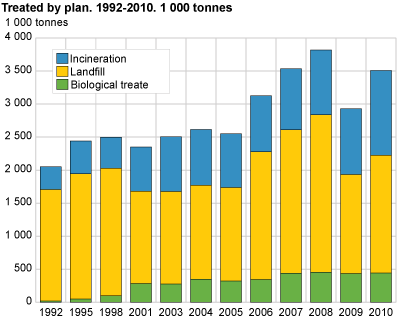Content
Published:
This is an archived release.
Corrected 18 January 2012
Large increase in waste incineration
Incineration of waste has more than doubled over the last 10 years. In 2010, around 1.17 million 6 tonnes of waste were incinerated - an increase of 17 per cent 6 compared to 2009.
The amount of waste composted or used for biogas production has stabilised at around 0.4 million tonnes.
| Year | Biological treated | Landfill | Incineration | Final disposal | |||||||||||||||||||||||||||||||||||||||||||||||||||||||||||||||||||||||||||
|---|---|---|---|---|---|---|---|---|---|---|---|---|---|---|---|---|---|---|---|---|---|---|---|---|---|---|---|---|---|---|---|---|---|---|---|---|---|---|---|---|---|---|---|---|---|---|---|---|---|---|---|---|---|---|---|---|---|---|---|---|---|---|---|---|---|---|---|---|---|---|---|---|---|---|---|---|---|---|---|
| Total | Energy utilization 1 | without energy utilization | |||||||||||||||||||||||||||||||||||||||||||||||||||||||||||||||||||||||||||||
| 1992 | 21 | 1 687 | 342 | 3 250 | 92 | 1 779 | |||||||||||||||||||||||||||||||||||||||||||||||||||||||||||||||||||||||||
| 1995 | 52 | 1 895 | 493 | 3 360 | 133 | 2 028 | |||||||||||||||||||||||||||||||||||||||||||||||||||||||||||||||||||||||||
| 1998 | 99 | 1 928 | 470 | 3 343 | 127 | 2 055 | |||||||||||||||||||||||||||||||||||||||||||||||||||||||||||||||||||||||||
| 2001 | 284 | 1 396 | 669 | 3 489 | 181 | 1 577 | |||||||||||||||||||||||||||||||||||||||||||||||||||||||||||||||||||||||||
| 2003 | 277 | 1 399 | 830 | 614 | 216 | 1 615 | |||||||||||||||||||||||||||||||||||||||||||||||||||||||||||||||||||||||||
| 2004 | 351 | 1 421 | 844 | 626 | 218 | 1 639 | |||||||||||||||||||||||||||||||||||||||||||||||||||||||||||||||||||||||||
| 2005 | 324 | 1 413 | 814 | 593 | 220 | 1 633 | |||||||||||||||||||||||||||||||||||||||||||||||||||||||||||||||||||||||||
| 2006 | 347 | 1 933 | 846 | 631 | 215 | 2 148 | |||||||||||||||||||||||||||||||||||||||||||||||||||||||||||||||||||||||||
| 2007 | 440 | 2 171 | 922 | 712 | 210 | 2 381 | |||||||||||||||||||||||||||||||||||||||||||||||||||||||||||||||||||||||||
| 2008 | 455 | 2 382 | 981 | 755 | 226 | 2 608 | |||||||||||||||||||||||||||||||||||||||||||||||||||||||||||||||||||||||||
| 2009 4 | 438 | 1 496 | 995 | 766 | 229 | 1 984 | |||||||||||||||||||||||||||||||||||||||||||||||||||||||||||||||||||||||||
| 2010 | 446 | 1 781 | 1 279 | 984 | 294 | 2 308 | |||||||||||||||||||||||||||||||||||||||||||||||||||||||||||||||||||||||||
| 1 | Excluding waste incinerated or landfilled by industrial local units. |
| 2 | Waste for material recovery not included. |
| 3 | Calculated from an avery energy recovery rate of 77 per cent at Norwegian waste incineration plants. |
| 4 | The method for collecting data is changed from 2008 to 2009 and this may cause uncertainties in the comparability between the years. Some manufacturing companies have a license to deposit at the site. This waste is a part of the statistics from 2009 onwards. Industrial local units may get licences for landfill on site. Such waste is excluded as well as landfilled hazardous waste. |
| Source: Waste statistics, Statistics Norway. | |
Contaminated soils subject to improved treatment
In 2010, around 1.8 million tonnes of waste were landfilled - an increase from 1.5 million tonnes in 2009. Since 2010, industrial landfills were also included in the statistics. The 2010 data show that 0.4 million tonnes of waste was disposed on industrial landfills.
A large share of the waste entering landfills consists of slightly polluted solids - around one-third of the landfilled amounts in 2009 and around two-thirds in 2010. Slightly polluted solids are mainly made up of soil, rocks and gravel originating from construction activities. Due to the pollution potential, these solids require separate treatment, but are still not classified as hazardous waste.
On 1 July 2009, the authorities imposed a ban on landfilling biologically degradable waste, such as paper, tree waste and food waste. A considerable number of dispensations were granted in 2009, and parts of 2010. Consequently, some municipalities still have dispensation and are allowed to landfill household waste until 2012. |
The amount of regular waste being landfilled showed a decrease from 1 million tonnes of waste in 2009 to 0.7 tonnes in 2010.
Methane emissions from landfills constitute around 2 per cent of total climate emission in the country, or around 1 million tonnes of CO 2 -equivaltents - a decrease of 0.8 million tonnes compared to 1990.
Waste applied as cover material largely reduced
The amount of waste applied as landscaping landfills decreased by almost 80 per cent from 2008 to 2010. Such landscaping landfills predominantly consist of slightly polluted solids and other mineral waste, plus smaller amounts of compost, and park and garden waste.
The introduction of the landfill ban in 2009 brought about a decrease of landfill waste, which again requires large amounts of landscaping landfills. Simultaneously, the amount of increased slightly polluted solids requires less landscaping landfills. In addition, stricter requirements have been set for what types of solids are allowed to be used as cover material, which has apparently led to a transition from using waste as landscaping landfills and replacing it with cleaner fractions like soils and pebbles.
The data collection has changed for the years 2009 and 2010. Before then, data were reported with one form per waste plant as part of a statistical survey. However, as from 2009, the statistics are based largely on data reported to the County Administrator or Climate and Pollution Agency. This change may have led to some increased uncertainty of the basic data, and a break in the time series between 2008 and 2009. |
For more information
Waste accounts for Norway
Environment.no
Tables:
- Table 1 Landfill. 2010. 1 000 tonnes
- Table 2 Waste incineration. 2010. 1 000 tonnes
- Table 3 Composting. 2010. 1 000 tonnes
6 Figures were corrected 18 January 2012, from 1.28 million tonnes and 28 per cent respectively.
Contact
-
Camilla Skjerpen
E-mail: camilla.skjerpen@ssb.no
tel.: (+47) 48 22 72 14
-
Mona E. Onstad
E-mail: mona.onstad@ssb.no
tel.: (+47) 48 59 61 86

